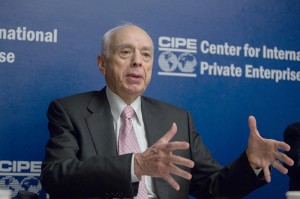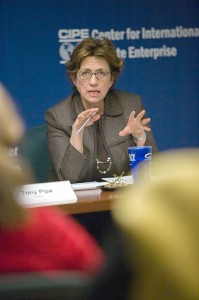Ownership the key to post-2015 development
By Jillian SlutzkerDecember 11, 2014
As the Millennium Development Goals end, today’s development practitioners must chart new goals that capitalize on programmatic successes, improve shortcomings and take into account markedly different realities on the ground, according to a panel of experts.
“It is a more complex and difficult environment than it was when the MDGS were formulated,” said U.S. Ambassador James Michel, a former U.S. Agency for International Development official and author of “Shaping the New Development Agenda,” speaking at a Dec. 9 panel on the same topic.
Fifteen years after the Millennium Development Goals were designed, development has changed, panelists said. The private sector is now a key player in stimulating growth. A surge in intrastate conflicts have rendered millions more vulnerable and less accessible. And good governance, rights and inclusion are priorities alongside economic progress.
In response, the development industry is “changing-both in the goals it is setting for itself and the way development is funded,” said Leland Kruvant, President of Creative Associates International, which co-hosted the discussion with the Center for International Private Enterprise.
Groups like the UN High Level Panel of Eminent Persons on the Post-2015 Development Agenda, which has proposed 12 new goals, and the Open Working Group on Sustainable Development Goals, which has proposed 17 goals, have taken these trends into account, said Michel.
Shifting paradigms
 With the emergence of new players in development—from donor blocs with members like Brazil and India to the private sector—the way the aid industry goes about development must change, panelists said. Donors are no longer conceiving of a North-South aid flow but rather a true global partnership.
With the emergence of new players in development—from donor blocs with members like Brazil and India to the private sector—the way the aid industry goes about development must change, panelists said. Donors are no longer conceiving of a North-South aid flow but rather a true global partnership.
The emphasis on the word “partner” in USAID’s new mission statement “forces us to think in cross-cutting ways,” said Tony Pippa, Deputy Assistant Administrator in the agency’s Bureau of Policy.
These new partnerships will capitalize on innovations in technology and development, Pippa said, and will prioritize local solutions and developing country ownership to ensure lasting outcomes.
Equally important, panelists said, is setting goals that center on inclusive growth, effective and accountable democratic institutions and climate sustainability—all critical elements to success in the post-2015 era.
“This paradigm shift in development is something that I think the US really welcomes,” Pippa said.
Private sector leadership
The private sector has long been a contributor to international aid, but the ways in which business invests in emerging markets today marks a move from philanthropy to smart social impact investing.
“Bill Gates doesn’t write checks anymore,” J.W. Wright, head of Creative’s Economic Growth Division, told the audience. “He writes programs and policies, and that is changing the dialogue.”
By investing in development, private companies can improve their “triple bottom line”— benefiting people, the planet and profits, wrote Bradford Strickland, economic growth expert at Creative, and Charito Kruvant, the company’s CEO, in their paper “Making Positive Social Impact an Everyday Part of International Business.”
As the development industry seeks to leverage the interests of the private sector, they should reach out to other entities besides big names like Microsoft and the Gates Foundation, said John D. Sullivan, Executive Director of the Center for International Private Enterprise.
“We always talk about public-private partnerships, and we think that means we are going to find a big multinational corporation to a form a partnership,” he said.
Small and medium enterprises in developing countries are not only valuable, he said, but in many cases, are essential to creating inclusive, sustainable growth.
Particularly in conflict and post-conflict settings, engaging the private sector can accelerate recovery and growth.
Sullivan said the informal sector, which according to the World Bank makes up from 25 percent to 40 percent of annual output in Asia and Africa, should also be brought into to economic growth efforts. Unlocking the potential of informal sector workers will be a boon to developing economies.
Beyond traditional partnerships, companies should also engage in dialogue with governments, Sullivan said, on how to create enabling environments for growth and investment. Without these institutional frameworks, inclusive growth and the other sustainable development goals will be hard to achieve.
Reaching the most vulnerable
Nowhere are these goals more difficult to achieve than in fragile and conflict-affected states.
More than 1.5 billion poor people live in places plagued by conflict and fragility, and more than half of the populations in post-conflict states live in poverty, according to the World Bank.
 “This is a class of countries for whom special needs are required if you really want development,” said Pauline Baker, President Emeritus of the Fund for Peace and contributing author to Creative’s series on Economic Growth, Fragility and Resilience.
“This is a class of countries for whom special needs are required if you really want development,” said Pauline Baker, President Emeritus of the Fund for Peace and contributing author to Creative’s series on Economic Growth, Fragility and Resilience.
Development progress is typically charted through indicators and data, which are hard to obtain in a crisis context. The Sustainable Development Goals, for example, stipulate a daunting 169 targets.
In these environments, Baker said, a census has often not been conducted for decades, records of land ownership are nonexistent and records like voter registration can be subject to political manipulation.
By only viewing development in a kind of “antiseptic way” and looking at economic indicators alone, Baker said, “you’re really writing off a whole class of conflict-affected states”
The new agenda, Baker said, must address the humanitarian and development needs of these most vulnerable people and build the resilience of societies and states to overcome fragility.
Development implementers cannot ignore these critical groups—including a surging youth population, millions of refugees and internally displaced people, and women who have been blocked out of political and economic development processes.
But reaching these populations will require some innovation.
“We are going to have to be more creative and come up with effective methods by which we can work in places coming out of conflict and achieve those development gains,” said Pippa.
Today’s development policymakers certainly have hurdles to overcome as they prepare for the post-2015 world, but with stronger partnerships and shared knowledge, these experts are optimistic.
“The potential benefits and the quality of the work to date provides grounds for hope and optimism that these efforts will contribute greatly to a sustainable world of freedom, opportunity and dignity for all,” Michel wrote in “Shaping the New Development Agenda”.
“The outcome cannot be guaranteed,” he wrote. “But the vision is certainly worth pursuing.”

